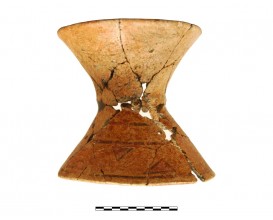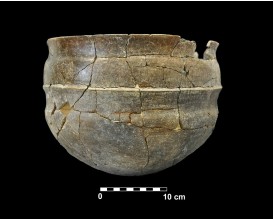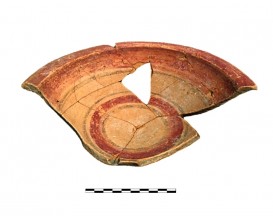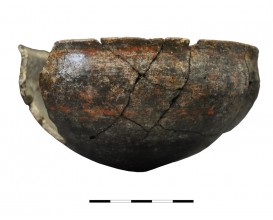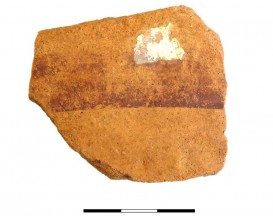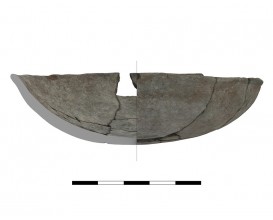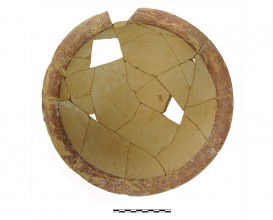Beads. Grave 5. Cemetery Cerro de los Vientos (Baeza, Jaén, Spain)
Carnelian belongs to the general group of chalcedony gems which are characterised by the presence of micro- or crypto-crystalline varieties of silica. The main component of chalcedony is α-quartz; it also contains a minor amount of moganite and a lot of opacifying and colouring impurities. Moganite is the monoclinic silica polymorph identified by its main band at 501 cm-1. The interpretation of the Raman spectra allows to confirm unambiguously the presence of both quartz and moganite.
EDXRF elemental analysis of the orange beads reveals approximately 99 wt% of SiO2 and a low concentration of Fe2O3, specifically below 0,11 wt% in both beads. This difference in composition separates this element from jasper, as the latter variety of chalcedony has high concentrations of Fe. The use of organic dyes to enhance red colouration can be discarded due to the absence of their characteristic Raman bands.
The occurrence of carnelian is particularly relevant, as it is not found in the Iberian Peninsula and the main supply areas was from India and the Sahara desert in Egypt.
Dimensions
: 0.5 izq Centimeters
: 0.5 izq Centimeters
: 0.6 der Centimeters
: 0.7 der Centimeters
Materials
Carnelian
Temporal
: Orientalising
: 8th-7th ct. BC
Spatial
: Cerro de los Vientos
: Puente del Obispo (Baeza, Jaén, Spain)
: WGS84
Copyrights
Creative Commons - Attribution, Non-Commercial, No Derivatives (BY-NC-ND)
References
Lechuga, M. A. y Soto, M. (2017): "La tumba de la mujer y el joven del Cerro de los Vientos (Puente del Obispo, Baeza)", en: Ruiz, A. y Molinos, M. (Eds.), Catálogo de la exposición La Dama, el Príncipe, el Héroe y la Diosa. Consejería de Cultura de la Junta de Andalucía, Sevilla, pp. 109-117.
Digital Resources
-
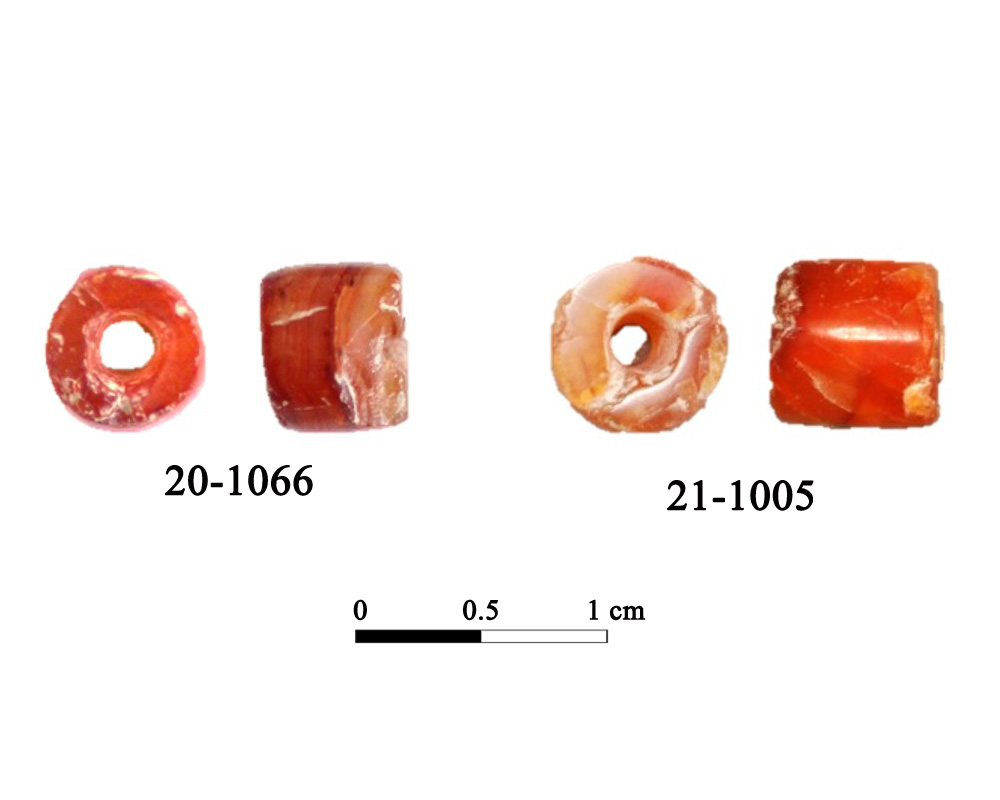 Instituto Universitario de Investigación en Arqueología Ibérica
Instituto Universitario de Investigación en Arqueología Ibérica Creative Commons - Attribution, Non-Commercial, No Derivatives (BY-NC-ND)
Arquiberlab
http://creativecommons.org/licenses/by-nc-nd/3.0/ -

Creative Commons - Attribution, Non-Commercial, No Derivatives (BY-NC-ND)
Arquiberlab
http://creativecommons.org/licenses/by-nc-nd/3.0/ -
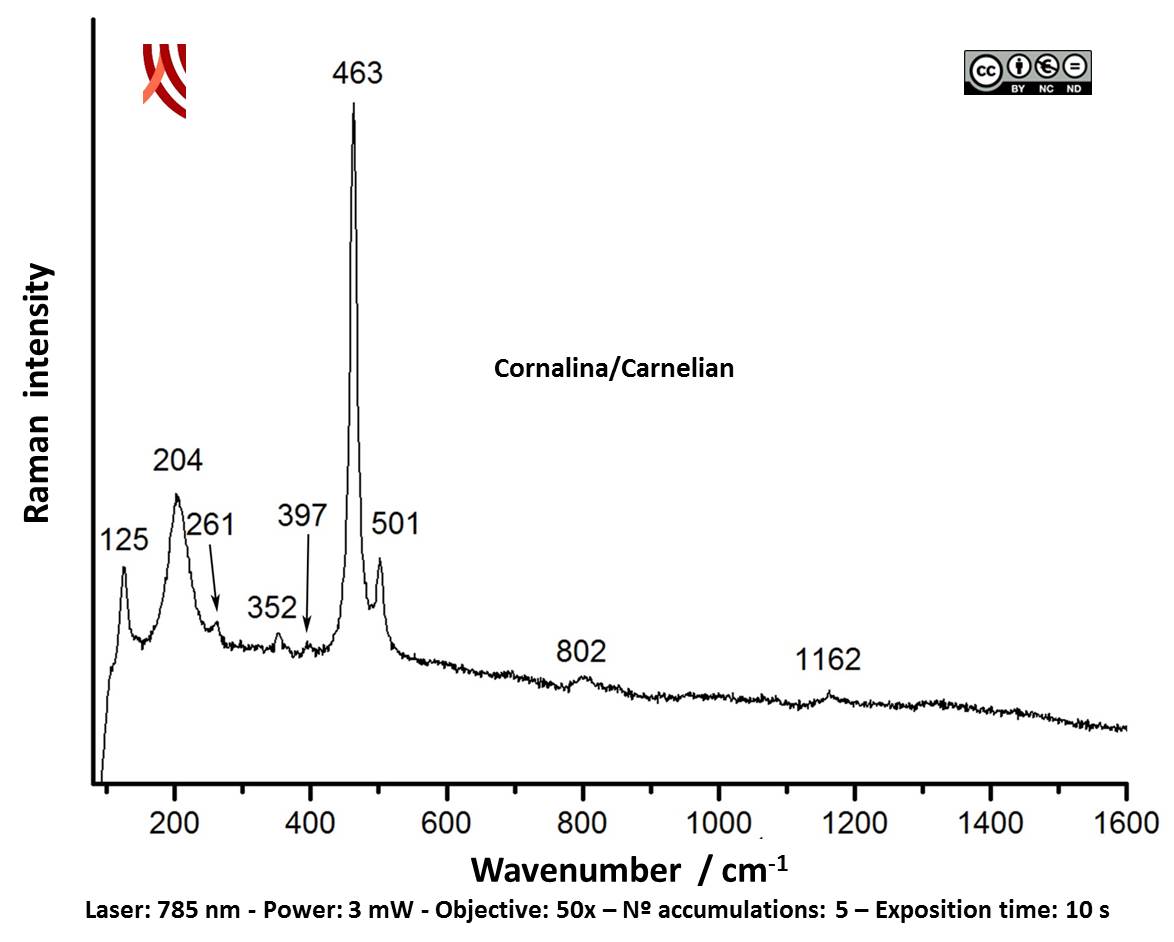 Instituto Universitario de Investigación en Arqueología Ibérica
Instituto Universitario de Investigación en Arqueología Ibérica Creative Commons - Attribution, Non-Commercial, No Derivatives (BY-NC-ND)
Arquiberlab
http://creativecommons.org/licenses/by-nc-nd/3.0/ - Instituto Universitario de Investigación en Arqueología Ibérica
pdf file
Creative Commons - Attribution, Non-Commercial, No Derivatives (BY-NC-ND)
Arquiberlab
http://creativecommons.org/licenses/by-nc-nd/3.0/
Activities
Archaeometric analysis Spectroscopic analysis Stone. Analysis of composition
| |
Raman Microscopy Mineral analysis Non destructive. Surface cleaning. Sample pretreatment is not required. Direct measurement. MRS Renishaw ‘in via’ Reflex Spectrometer coupled with a confocal Leica DM LM microscope (CICT, University of Jaén), equipped with an argon ion laser (514.5 nm, 25mW), diode laser (785 nm, 300 mW), a Peltier-cooled CCD detector, and calibrated to the 520.5 cm-1 line of silicon. | |
X-Ray Fluorescence Elemental analysis Non destructive. Surface cleaning. Sample pretreatment is not required. Direct measurement.; Energy dispersive X- ray fluorescence (EDXRF) An energy dispersive X-ray microfluorescence spectrometer (M4 Tornado, Bruker) (CICT, University of Jaen). This spectrometer is equipped with a microfocus X-ray tube with an Rh anode, a polycapillary lens for X-ray focussing, and a 30-mm2 energy dispersive detector (SDD). The sample chamber incorporates an XYZ motorized stage for sample positioning. A high resolution microscope is used to position the sample on the desired distance from the polycapillary. To increase the sensitivity of the low Z elements, the sample chamber can be brought under vacuum. For the analysis of the samples, a spot size of 25 μm was chosen at an operating X-ray tube voltage of 50 kV and intensity of 600 μA. The tube current was adapted for each sample in order to optimise the detection of X-rays. |



